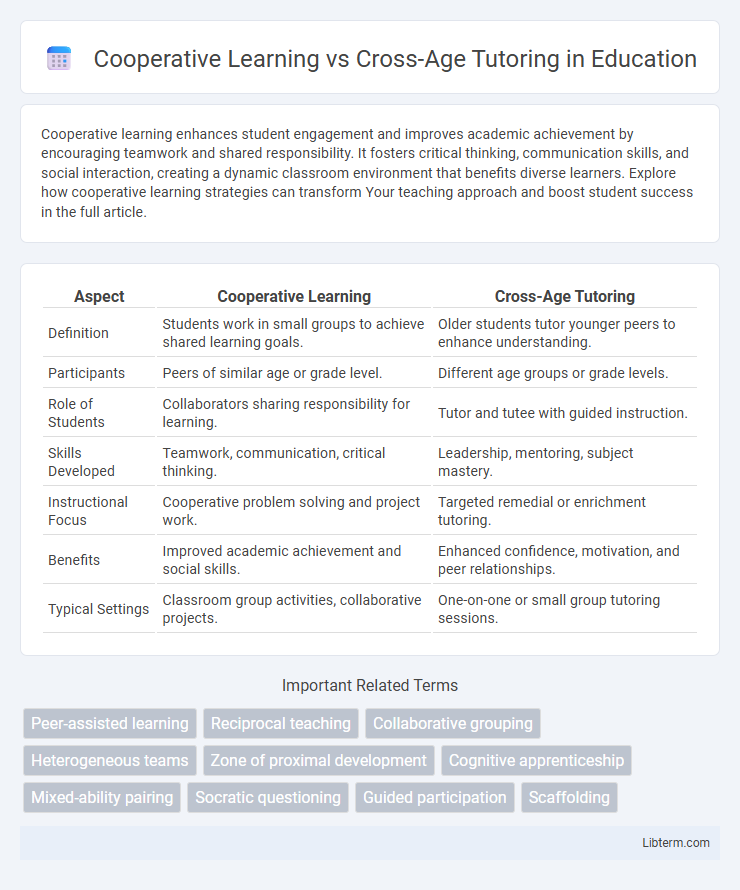Cooperative learning enhances student engagement and improves academic achievement by encouraging teamwork and shared responsibility. It fosters critical thinking, communication skills, and social interaction, creating a dynamic classroom environment that benefits diverse learners. Explore how cooperative learning strategies can transform Your teaching approach and boost student success in the full article.
Table of Comparison
| Aspect | Cooperative Learning | Cross-Age Tutoring |
|---|---|---|
| Definition | Students work in small groups to achieve shared learning goals. | Older students tutor younger peers to enhance understanding. |
| Participants | Peers of similar age or grade level. | Different age groups or grade levels. |
| Role of Students | Collaborators sharing responsibility for learning. | Tutor and tutee with guided instruction. |
| Skills Developed | Teamwork, communication, critical thinking. | Leadership, mentoring, subject mastery. |
| Instructional Focus | Cooperative problem solving and project work. | Targeted remedial or enrichment tutoring. |
| Benefits | Improved academic achievement and social skills. | Enhanced confidence, motivation, and peer relationships. |
| Typical Settings | Classroom group activities, collaborative projects. | One-on-one or small group tutoring sessions. |
Introduction to Cooperative Learning and Cross-Age Tutoring
Cooperative learning is an instructional strategy where small groups of students work together to achieve shared learning goals, emphasizing collaboration, interdependence, and individual accountability. Cross-age tutoring involves older students providing academic assistance and mentorship to younger peers, fostering skill development and reinforcing knowledge for both tutors and tutees. Both approaches enhance engagement and improve academic outcomes by promoting active participation and personalized support.
Defining Cooperative Learning: Key Principles
Cooperative learning is an educational approach where students work together in small groups to achieve shared learning goals, emphasizing positive interdependence, individual accountability, and face-to-face promotive interaction. Key principles include structured group roles, equal participation, collaborative problem-solving, and developing social skills alongside academic content. This method fosters deeper understanding and critical thinking by encouraging communication and peer support within diverse learning groups.
Understanding Cross-Age Tutoring: Essential Features
Cross-age tutoring involves older students providing academic support and mentoring to younger peers, promoting individualized learning and social development. Key features include role reversal where tutors reinforce their own knowledge while tutees benefit from tailored assistance within a supportive relationship. This approach enhances motivation, bridges skill gaps, and fosters collaborative peer interactions across age groups.
Cognitive Benefits of Cooperative Learning
Cooperative learning enhances cognitive development by promoting critical thinking, problem-solving skills, and deeper understanding through collaborative dialogue among peers. Engaging in group tasks requires learners to process information actively, articulate ideas, and integrate diverse perspectives, fostering higher-level cognitive functions. This interactive approach contrasts with cross-age tutoring, as cooperative learning emphasizes collective reasoning and equal participation, leading to improved retention and knowledge construction.
Social and Emotional Gains from Cross-Age Tutoring
Cross-age tutoring fosters significant social and emotional gains by enhancing empathy, communication skills, and self-confidence as older students mentor younger peers. This method promotes responsibility and leadership in tutors while providing tutees with personalized support and positive role models. Compared to cooperative learning, cross-age tutoring uniquely strengthens intergenerational connections, boosting emotional intelligence and social development for both age groups.
Classroom Implementation Strategies
Cooperative learning involves structured group activities where students work collaboratively, sharing equal responsibility for completing tasks and developing social skills, often using roles and positive interdependence to enhance engagement. Cross-age tutoring pairs older students with younger peers for one-on-one instructional support, emphasizing mentoring relationships, individualized feedback, and skill reinforcement tailored to the tutee's needs. Effective classroom implementation of these strategies requires clear role definitions, consistent monitoring by teachers, and scaffolding techniques that promote active participation and target specific learning objectives.
Comparing Outcomes: Academic Achievement
Cooperative learning fosters collaborative problem-solving skills and has been shown to improve academic achievement by promoting active engagement and peer interaction within same-age groups. Cross-age tutoring pairs older students with younger learners, resulting in significant gains in both tutors' and tutees' academic performance due to personalized instruction and increased responsibility. Studies indicate cooperative learning excels in enhancing group dynamics, while cross-age tutoring provides tailored academic reinforcement and boosts confidence across age levels.
Teacher’s Role in Both Approaches
In cooperative learning, the teacher acts as a facilitator who designs group activities, monitors student interactions, and ensures equitable participation to promote collaborative problem-solving skills. In cross-age tutoring, the teacher assumes a supervisory and mentor role, selecting appropriate tutor-tutee pairs and providing guidance to empower older students to support younger peers effectively. Both approaches require the teacher to create structured, supportive environments that foster peer learning while addressing individual needs.
Challenges and Limitations
Cooperative learning faces challenges such as uneven participation, where dominant students may overshadow quieter peers, reducing overall effectiveness. Cross-age tutoring encounters limitations like mismatched skill levels and potential role confusion, which can hinder both learning outcomes and social dynamics. Both methods require structured oversight to prevent these issues and maximize educational benefits.
Choosing the Right Approach: Practical Considerations
Cooperative learning involves peer collaboration within the same age group to enhance problem-solving and social skills, while cross-age tutoring pairs older students with younger learners for mentorship and academic support. Choosing the right approach requires evaluating factors such as student maturity, curriculum goals, and available resources to foster effective interaction and knowledge transfer. Practical considerations include assessing group dynamics, aligning with instructional objectives, and ensuring adequate training for tutors to maximize educational benefits.
Cooperative Learning Infographic

 libterm.com
libterm.com